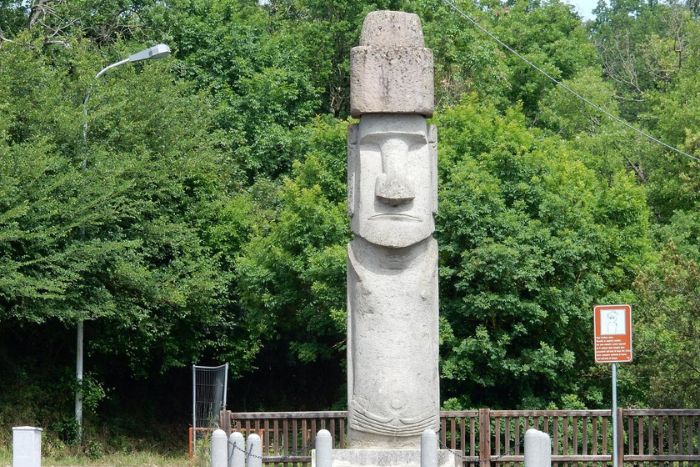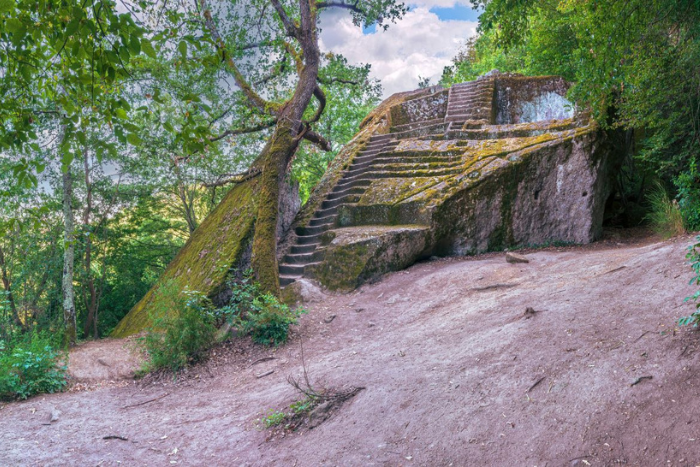The History of the Moai Statue of Vitorchiano
A pochi chilometri da Viterbo sorge Vitorchiano, lo splendido borgo della Tuscia sospeso sulle rocce vulcaniche. E qui si trova l’unica statua Moai al mondo, al di fuori dell’Isola di Pasqua.
Table of contents:
A soli quindici minuti d’auto da Viterbo, sorge Vitorchiano, antico borgo e gioiello storico incastonato tra le rocce vulcaniche della Tuscia. Considerato uno dei centri storici più suggestivi della provincia di Viterbo, gode anche del prestigioso riconoscimento di uno dei “borghi più belli d’Italia”. E qui troviamo anche l’unico originale monolite Moai al mondo, al di fuori dell’Isola di Pasqua (o Rapa Nui).
What Borgo Sospeso means
L’integrità del suo nucleo antico, le abitazioni che sembrano fondersi armoniosamente con le scogliere di peperino su cui sono erette, conferiscono a Vitorchiano il suo appellativo distintivo: il Borgo Sospeso. L’origine di questa denominazione risiede nella geologia unica della zona. I depositi di materiali vulcanici, modellati nel corso dei millenni dall’attività dei vulcani, hanno dato vita alle imponenti rupi su cui sorgono i borghi della Tuscia. Tuttavia, ciò che rende Vitorchiano veramente speciale è il suo banco di peperino, fratturato in enormi massi, su cui poggiano direttamente gli edifici del borgo. Questa peculiarità crea un’illusione visiva affascinante, facendo sembrare che il borgo sia stato scolpito nella roccia. Le case, aggrappate e a strapiombo, si fondono con la roccia lavica, creando un’armonia perfetta con la Valle del Vezza e il paesaggio circostante, ricco di boschi di querce, frassini, faggi, olmi e castagni.
Cos’è il Moai di Vitorchiano
E proprio la ricchezza di peperino ha fatto si che Vitorchiano divenisse il luogo perfetto per costruire una gigantesca statua Moai. Le statue Moai sono monoliti antropomorfi scolpiti dalla popolazione polinesiana indigena Rapa Nui (che è anche il nome originario dell’Isola di Pasqua), in gran parte tra il 1100 e il 1500. Si tratta di veri e propri giganti di pietra alti fino a 21 metri, probabilmente monoliti augurali portatori di benessere e prosperità dove volgono lo sguardo. Il Moai di Vitorchiano venne realizzato nel 1990 della famiglia Atan, originaria di Rapa Nui e composta da 19 persone. L’occasione della costruzione del monolite di Vitorchiano fu la trasmissione televisiva RAI “Alla Ricerca dell’Arca” del giornalista Mino D’Amato. Intenzionato a promuovere il restauro dei Moai dell’Isola di Pasqua, il giornalista cercava in Italia una pietra che si avvicinasse il più possibile alla pietra vulcanica con cui furono realizzati i giganti di Rapa Nui, con la quale realizzare un Moai italiano. Vitorchiano, patria del peperino, fu individuato come luogo ideale dove realizzare l’opera, e la famiglia Atan i giusti artigiani.
Come è fatto il Moai di Vitorchiano
Dopo mesi di lavoro, gli Atan realizzarono un originale Moai lavorando la pietra con le stesse antiche tecniche impiegate sull’Isola di Pasqua per la costruzione dei Maoi originali. Dal punto di vista artistico, il Moai di Vitorchiano è una testimonianza dell’abilità e della maestria degli scultori. Fedele agli originali, la statua presenta solchi profondi, tratti duri, semplici e lineari, e dettagli curati come le orecchie lunghe, l’ombelico sottolineato e le mani affusolate aderenti al ventre. Ancora oggi il Moai di Vitorchiano rappresenta l’unica scultura Moai in pietra di dimensioni originali, presente al di fuori dell’Isola di Pasqua.
Where the Moai of Vitorchiano is located
La statua del Moai ha attraversato diverse collocazioni nel corso degli anni. Dapprima situata al centro del piazzale Umberto I, nel 2007 fu temporaneamente trasferita in Sardegna per essere esposta in una mostra di arte precolombiana. Tornata a Vitorchiano dopo nove mesi, la statua trovò la sua definitiva collocazione su Largo Padre Ettore Salimbeni, nell’area camper del comune che si affaccia sul suggestivo belvedere del “Borgo Sospeso”.
Il Moai di Vitorchiano, con la sua presenza imponente e la sua storia affascinante, si erge come un’icona di uno dei borghi più belli d’Italia, rappresentando un legame unico tra la storia millenaria dell’Isola di Pasqua e la bellezza intramontabile di Vitorchiano, il borgo sospeso della Tuscia.




